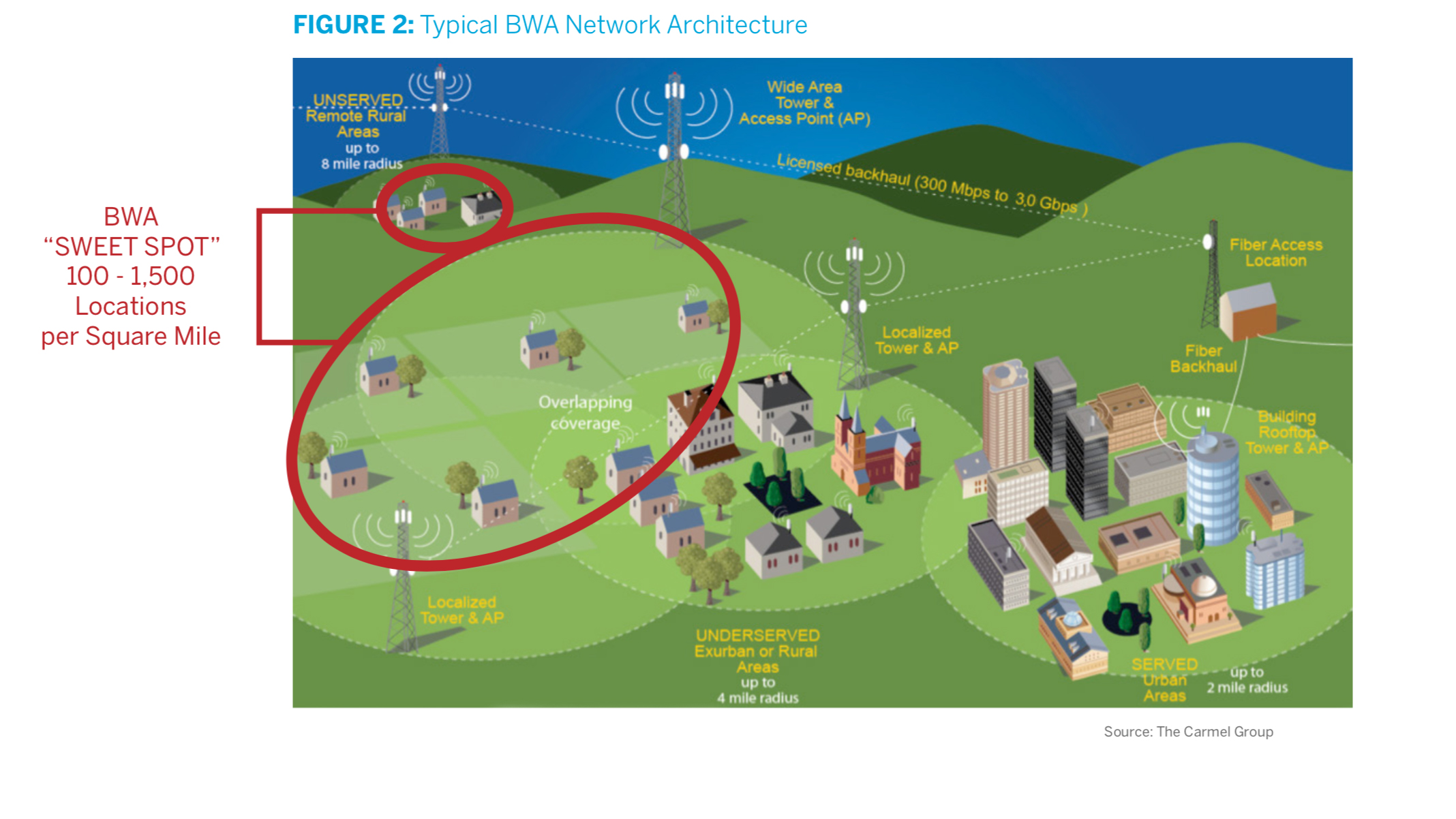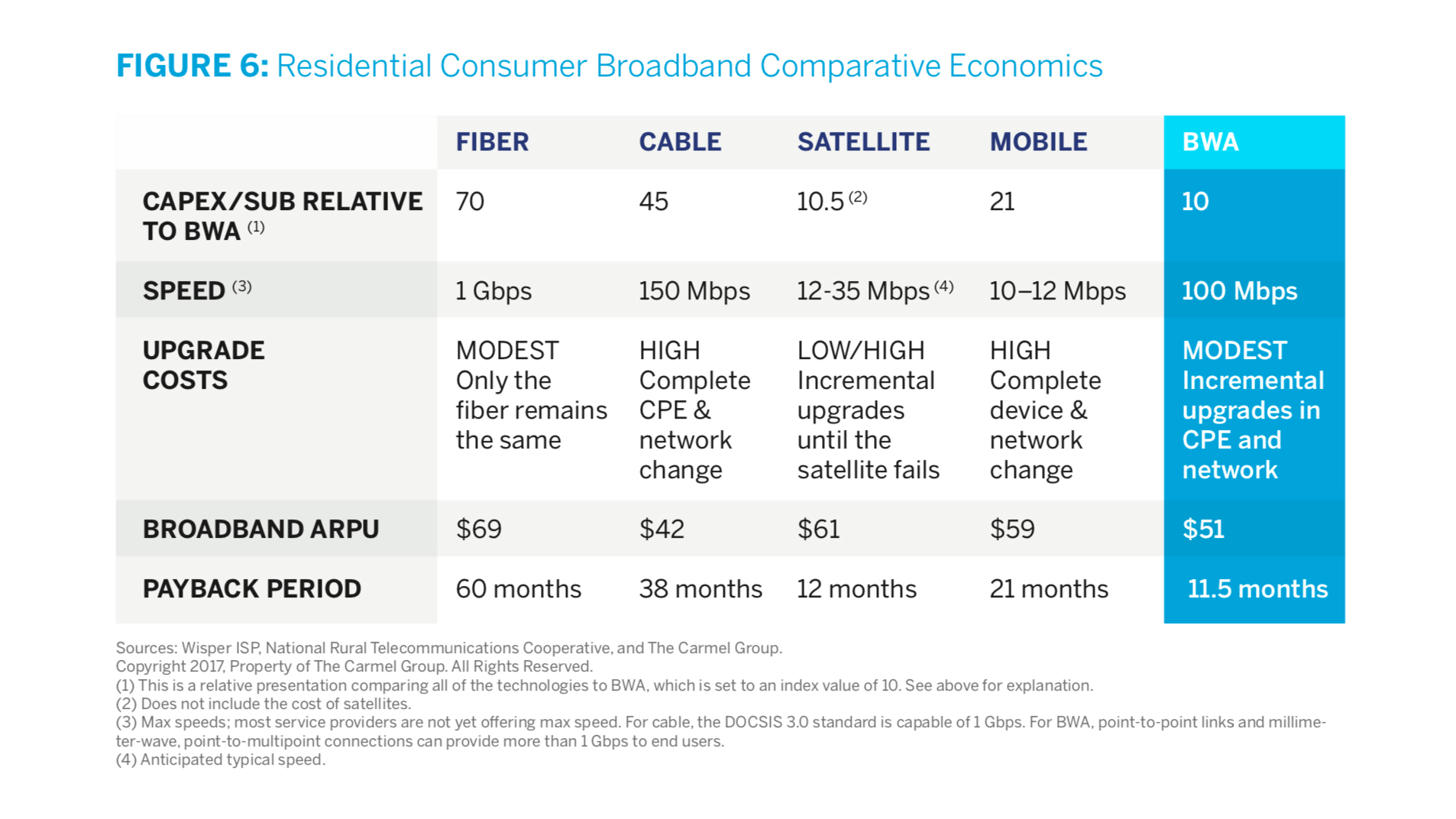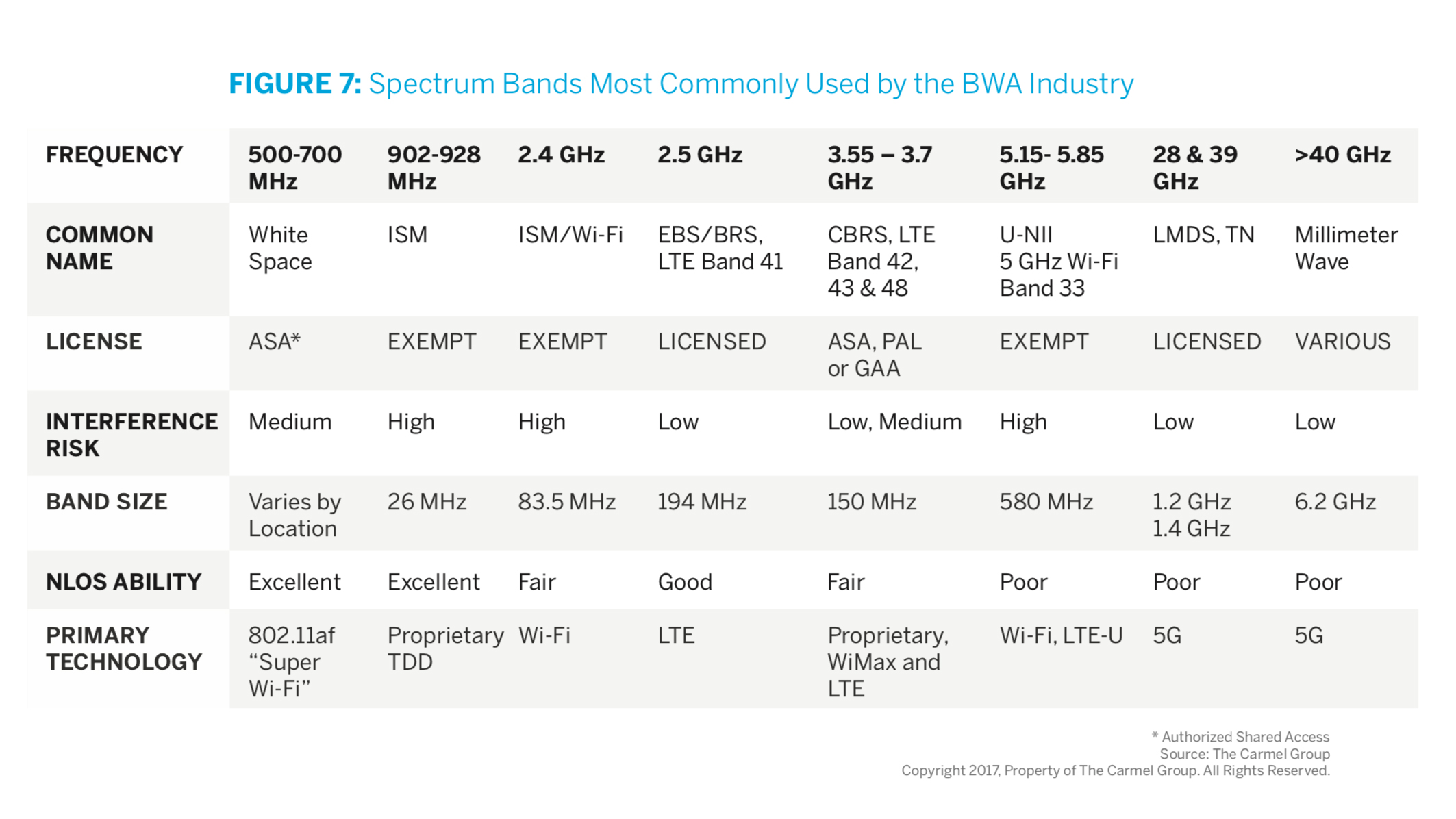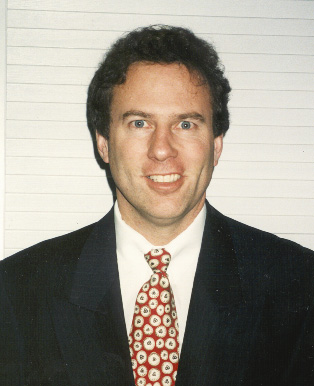Fixed Wireless 101: What Rivals Need to Know
Within the last several calendar quarters, the U.S. fixed wireless community has been extensively researched, written about, and analyzed. That resulted in a ground-breaking 23-page study, titled the “Broadband Wireless Access Report” (“2017 BWA Report”).
Fixed Wireless Graphic
As depicted in the accompanying graphic, the infrastructure basics of the U.S. fixed wireless industry usually involve the following:
- Delivery via a trunk, or “backhaul,” of content, typically in the form of a satellite, fixed wireless, and/or fiber optic pipe;
- Termination of that backhaul at a tower or other elevated point;
- Further distribution of that content from the tower to another tower, further away (also known as point-to-point distribution of content);
- And/or further distribution of that content from the final tower to the actual user/subscriber (also known as point-to-multipoint);
- Installation of consumer premises equipment (CPE) at the user end-point, e.g., a home or business;
- Such CPE typically involves an outside antenna, plus wiring from outside to inside, and an inside modem to distribute the signal in a wired or wireless fashion within the dwelling and/or office building; and
- Finally, a central office monitoring point for storage and management of those signals and content.

Relevant Data Points
The Carmel Group research offers some fascinating data, most of it remaining relevant, and some highlights bullet-pointed below. As the comparative graphic below suggests, the essence of the fixed wireless message today is that in many instances it can deploy more cheaply than competitors, and with more than ample quality and bandwidth. Those rivals include cable, fiber, satellite, and mobile/cellular. The proprietary data points listed below are grouped first for operators; and second for fixed wireless vendors.
Two huge underlying surveys of several hundred WISPA operators, and several dozen manufacturer vendors reveal data points that include the following.
Operators
- One quarter of fixed wireless operators deliver services in areas that “pass” (or access) more than 10,000 homes.
- Half of operators see year-over-year subscriber growth rates of 10%-20%.
- There are more than 2,100 fixed wireless operators in the U.S. today.
- There are approximately six million U.S. fixed wireless users today.
- Estimates of fixed wireless industry revenues approach $4 billion for year-end 2019.
- The fixed wireless subscriber base is growing; meanwhile, the bases of other users, including broadcast and pay TV, are declining.
- Most WISPA operators remain relatively small. Today’s average system size is between 1,000 and 2,000. One half of all respondents have less than 1,000 subs.
- Fixed wireless churn rates are low. More than half are at less than 0.5%; slightly less than three quarters of all operators display less than 1% annual churn.
- Three quarters of all respondents declared Average Revenue Per Unit (ARPU) of greater than $50 for residential users, and rising at a solid rate. Commercial, governmental and institutional users report typical monthly ARPU of greater than $500.
- Residential Subscriber Acquisition Costs (SAC) are above $51/month and rising for three quarters of the fixed wireless WISPs reporting.
- Almost six out of ten of all new subscribers are truly new subscribers, whereas almost four out of ten are subscribers coming from another broadband provider.
- By year-end 2021, more than twenty percent of survey respondents expect to have a subscriber base of between 3,501 and 6,000 users.
- Nearly nine out of ten WISPs use unlicensed spectrum at access points, while slightly more than one out of ten in the same sub-category use licensed.
- Most respondents saw great future potential in the areas of 1) business/enterprise, governmental and institutional customer growth, 2) building redundant back-up fixed wireless systems, and 3) creating “hybrid networks,” i.e., typically adding fiber, but often even cable and satellite side-businesses.
- Operators expect the greatest future growth to come in the areas of 1) equipment capability, and 2) spectrum improvements.
- The four top challenges WISPs reported were 1) lack of spectrum, 2) noise and interference, 3) excessive governmental regulations, and 4) increased operating costs.
- The top three competitive advantages surveyed, in order, were 1) network technical capability, 2) local presence, and 3) customer service.
Vendors
- Half of all vendors, on average, are seeing three-year sales growth rates of between 16% and 45%.
- Approximately 80% vendors describe their WISP industry products as hardware-related, while three out ten list software-related (acknowledging a handful who manufacture and deliver both).
- Three quarters of all vendors look to provide technology improvements that deliver more value/unit, and two-thirds list both improvements in speeds/throughput and reliability. Six out of ten feel delivering more quality is important.
- More than ninety percent of fixed wireless vendors state that email is the most important form of customer support. Roughly sixty percent also utilize/prioritize 1) online community forums, 2) 24/7 phone customer service representatives (CSRs), and 3) social media.
- The top four fixed wireless vendor competitive advantages reported were 1) customer value for the payment, 2) customer service, 3) network technical reliability, and 4) network speed/capacity/throughput.
- More than half of the fixed wireless vendors estimated their own future three-year growth at between 30% and 100%.
- More cable operators are buying fixed wireless systems; and see, discussion below of and with D. Giles, new GM of the fixed wireless and multiple cable system operator (MSO), Midco).
- This creation of new “hybrid networks” lines up with the title of this column/blog, “Mixed Signals.” The author has felt for decades that the merging of operators like cable and satellite, or fiber and cellular/mobile (and many other combinations), has often been the preferable way of delivering telecom content to all users.

Key Fixed Wireless Industry Participants
As part of this column, three prominent members of the dominant trade group for the U.S. wireless industry were consulted for their wisdom, experience, and insight. This included Wireless Internet Service Providers’ Association (WISPA) board members Jeff Kohler, co-founder and chief development officer of the Englewood, CO-based operator, Rise Broadband; Mark Radabaugh, CEO of the Luckey, OH-based operator, Amplex; and Dave Giles, General Manager for Fixed Wireless of the Sioux Falls, SD-based operator, Midco.
Recent Key Challenges and Opportunities
All three WISPA board members honed in on spectrum, when asked their opinion of top current challenges. Relatedly, several trends were also highlighted, and worth grappling with, they said.
Spectrum, Economics, Etc.
Note was made by Midco’s Giles of the challenge faced by WISPA’s mostly rural and often small operators of communicating spectrum needs to legislators, especially vis-à-vis competition from bigger telecom providers. The cable-fixed wireless company GM also spoke pro-actively of his board’s efforts to “shop the idea of a spectrum inventory” as a way to better manage spectrum resources, including unused spectrum. He offered the idea of spectrum sharing of C-Band, as an example. As yet another example, Giles suggested that Ku-Band spectrum is not especially good for use by mobile providers, yet “great for wireless.”
Rise’s Kohler stated that his company sees “the ability to offer faster speeds.” Using millimeter wave spectrum and technology is proving to offer up to gigabit speeds,” he added. “It is early stage, but it is being proven.” Yet, that said, a strongly felt message of Kohler’s for years has been balancing that potential against what speed consumers think they need, relative to what is actually needed in their average day-to-day usage. Pointing to a recent technology study by a company called Preseem, Kohler used an example of the average fixed wireless subscriber using just over four Megabits Per Second (Mbps), suggesting instead that delivery of speed in the range of twenty megabits down and five megabits up is more than sufficient for the average user, and that “consumers need to be educated that they don’t need anything close to a gigabit of speed down, consumers do not need to buy the hype cable and fiber providers are selling.” Put another way, Kohler believes that “companies are artificially driving up the ARPU, by convincing consumers they need something that they don’t.”
For his part, Amplex’s Mark Radabaugh was perhaps more pithy, instead focusing directly on the hype around the new 5G technology and its effect on content delivery. He noted that a huge mobile industry focus on 5G comes years after fixed wireless providers began offering similar bandwidth capabilities. “Fixed wireless hybrid providers have been providing alternatives to telco and cable models, using high-speed wireless broadband, and doing that for years,” he adds.
Beyond spectrum and regulatory concerns, Giles noted the challenge of changing economics as most WISPs get bigger. “Adding staff, financing…every layer of growth adds complexity,” he commented, “the challenge is understanding the technology.”
Giles also tried to dispel a myth he sees of WISP newbees, who get the idea that fixed wireless is simply a matter of “buying a radio and consumer premises equipment, and plugging them in.” Reality for Giles suggests every WISP operator needs to understand at least 1) the competition, 2) the bandwidth, and 3) the environment. He concludes, “If you use the right technologies, your opportunities are awesome. But the bottom line is that many decisions can have a huge impact, so it’s a really good place for the strategic mind.”

Trends
Fixed wireless networks becoming “Hybrid Networks” is a clear trend. That is to say, fiber has already been deployed, or is being looked at, by a large number of fixed wireless operators. These operators realize that fiber is more and more a superior pipe, usually dependent upon installation costs and the number of users accessed. The trend of fixed wireless operators also becoming cable operators (or vice versa), has begun. Moreover, many fixed wireless operators mix in a side business of DISH and DirecTV satellite TV installation, with strong doses of revenue-sharing to make it work for all participants.
Midco’s Giles highlighted the trend of more consumers using more bandwidth, on more devices, in more places, and during more hours of the day. Giles notes, “Today the average consumer has four to five devices, ranging from laptops to ipads to cells to thermostats to security to more and more of everything. That demand is far from peaking.”
Another trend highlighted by Rise’s Kohler involves education. As noted above, he is intent on making subscribers wiser, by getting them to understand and accept that not every pipe into the home needs to deliver a gigabit of speed in order to serve that subscriber’s needs. Kohler added Long Term Evolution (LTE) technology to his list of new tech examples that offer huge opportunities to new and established WISPs and
hybrid operators.
Like Giles, Kohler further opines about the importance of good strategy and management techniques. “In the absence of a great deal more spectrum, Rise finds that expertise in managing tower-to-the-home and tower-to-the-business is becoming critical. We find network deployment skills can overcome the constant need for and contention over spectrum.”
And even though he notes that most consumers don’t need the speed that is being pitched them, for those that do, Kohler points out technology improvements that offer affordable bandwidth in the range of 200 Mbps of speed. Changes such as “getting infrastructure closer to the customer, and microcells are making these a reality,” he notes.
A recent Telecompetitor article highlights hybrid operator Redzone’s capabilities over those of Fiber To The Household (FTTH) operators, in more parts of rural Maine. From significant study, the author has found Redzone to be something of a model wireless Internet service provider, or WISP. This is due to a great combination of factors, including being on the favorable side of
many of the data points studied and highlighted above.
Several of the trends noted above were also described as opportunities.
Jimmy Schaeffler is the chair and CSO of The Carmel Group, a broadband, broadcast, and pay TV/video consultancy. He has spent nearly five decades producing, studying, writing, researching and analyzing, and working with every type of player in the space. If you are looking to expand or better understand the industry, feel free to reach out to him atjimmy@carmelgroup.com, or go online towww.carmelgroup.com.
The smarter way to stay on top of the multichannel video marketplace. Sign up below.
Jimmy Schaeffler is chairman and CSO of The Carmel Group, a nearly three-decades-old west coast-based telecom and entertainment consultancy founded in 1995.

